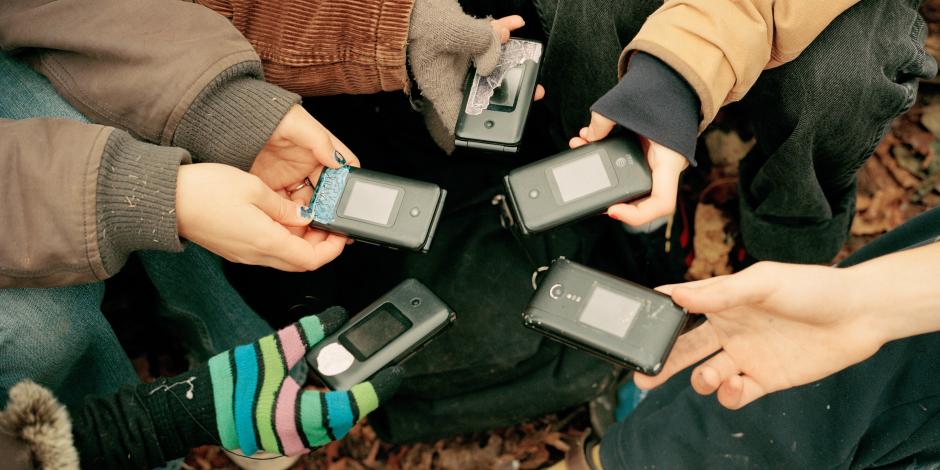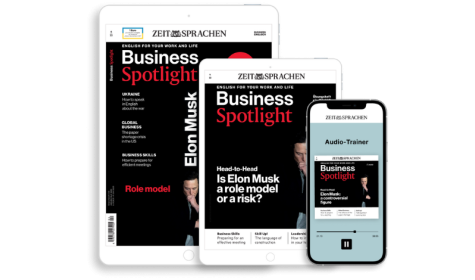Starten Sie den Audio-Text
Mit dem Audio-Player können Sie sich den Text anhören. Darunter finden Sie das Transkript.
Sion: Do you find you waste a lot of time on your phone, scrolling social media or compulsivelyzwanghaftcompulsively checking your email? Joe Hollier, the cofounder of Light, the creators of the Light Phone, recognized this problem and created a phone that could do less rather than more.
Along with his fellow cofounder, Kaiwei Tang, he set out to create a tech company that didn’t center around a business model of making their users make sb. addictedjmdn. süchtig machenaddicted. Hollier spoke to Business Spotlight correspondent Elitsa Gadeva about the genesisEntstehung(sgeschichte)genesis of this idea.
Joe: In 2014, Google had this idea for an experimental incubatorhier: Inkubator-, Förderprogrammincubator called “30 Weeks.” And, you know, it’s ironic that Google was the catalyst for this, but it was in this program that I not only met my partner, Kaiwei [Tang], but we were sort of encouraged to look at the tech world. We met maybe 100 different founders throughout the course of this program, who all gave us very intimate explanations of sort of how and why they built their different businesses. And there was this trend that Kaiwei and I saw, which was around this metric of retentionRetention, Nutzerbindungretention. So, if you could make something that was stickyklebrig; hier: beharrlichsticky, that people would spend hours a day on your website or your platform or your app, there was a business model that could be made by collecting data and selling advertisement and, you know, venture capitalists, they loved this business model. And that was sort of the blueprintBlaupauseblueprint for so many of the start-ups that were happening around that time.
And it kind of got me thinking, “Well, geedu meine Gütegee, like, if I make some app that gets us to spend one more hour on our phone, is that actually going to make any of us happier? Or when I look at my own relationship with my phone, am I ready to throw it off a cliff and go live off the gridabgekoppelt vom Versorgungsnetz lebenlive off the grid in a cabin somewhere?” And, you know, maybe there’s some middle ground that we could find some balance in.
Sion: Joe reflected on what he liked about the separation of his offline and online worlds when he was younger. Some of these ideas were instrumental when developing the Light Phone.
Joe: I thought a lot about AOL instant messenger. That was sort of the internet that I grew up in [non-standard], where there was one computer in my dad’s room with a modem. And if I went in that chair on that computer, I could be on the internet. But as soon as I left that chair, I left the internet behind. So, I really appreciate sth.etw. schätzenappreciated that clear divide of online and offline, where now that I had a smartphone, I checked my email or social media before even brushing my teeth. And right before going to bed and, like, a trillionBillion(en)trillion times throughout the day, as I’m sure everyone sort of does. And so, we wanted to create a way for people to intentionally “go light,” as we coin sth.etw. prägen; hier: (be)nennencoin it — to step away, to put up an “away” message and say, “I don’t want my smartphone for the next few hours. I’m going to be present with my partner, or with my art studio practice, or with, like, you know, my family, or I’m gonna go for a walk, or I go to a movie, and I’m not going to have the noise before and after of a smartphone.”
Sion: Joe then explained that the original idea for the Light Phone was to supplement sth.etw. ergänzensupplement a user’s smartphone rather than replace it.
Joe: The original Light Phone idea was actually your “phone-away-from-phone,” so that you would have this really small, simple phone — that, you know, peace of mind. God forbid there’s an emergency, I can call, you know, my close friends and family, and they can reach me. But all of the other noise was sort of be stuckfestsitzenstuck at home on the smartphone, and I’d come back to it at some point, and sort of questioning this idea that we had to be so hyperconnected and always available. This expectation of “you must reply to a text in a minute.” You know, I sort of felt that was extreme and a very new phenomenon actually in the scheme of history.
Sion: Joe and Kaiwei used their findingsErgebnisse, Erkenntnissefindings from studying people’s behaviour when building the first version of the Light Phone.
Joe: We started giving people flip phoneKlapphandyflip phones before we actually made the Light Phone and testing it, and, you know, it proved really valuable. People would take our flip phone for the afternoon, for the weekend, and when we looked at the phone, they didn’t use it at all. The real value was their presence in their day-to-day life, the peace of mind, and they’re sort of, like, able to relax truly for the first time in a while.
And so, it kind of coined this term “design sth.hier: etw. konzipierendesigned to be used as little as possible.” And that’s really kind of been our North StarPolarstern; hier: Leitstern, OrientierungspunktNorth Star for the design principles of the phone, making it the size of a credit card, something you’d be able to fit in your wallet or your bag or pocket to only having nine speed dials. And then we launched that on Kickstarter in 2015, and we started shippingVersandshipping that in 2017.
Sion: Joe explained how some of the limitations of the first Light Phone led them to develop a second version.
Joe: We sort of realized that there was [non-standard] a lot of people that really loved going “light” — almost to the extent that, you know, I myself, I felt this as well. I didn’t necessarily think I needed a full-blownvoll entwickeltfull-blown smartphone. But the Light Phone I was so limited to only phone calls and only nine speed dialhier: Kurzwahlnummerspeed dials that I said, “Hey, if only I had a contact book, maybe some textingSimsentexting and maybe a few tools like an alarm, then maybe I wouldn’t need a smartphone or I might be able to leave my smartphone for much larger and longer chunk of timeMenge Zeitchunks of time.”
So, that was kind of where the idea for the Light Phone II was born. And that one was a little bit bigger, and it had an e-ink screen. So, it was a really small, slow screen — just a different cadence, like the speed at which you interact with the device. On a smartphone, you’re just like click, click. You almost move faster than you could think. But on this, you had to be, like, “I’m going to set an alarm.” Open this. Click “alarm.” And so, it really forced you to slow down. And it was too much for some people to make that leapden Schritt wagenmake that leap. But for the people that were able to really acclimate and bring it into the lifestyle, either as their primary phone or as a phone that they would go between to, it really had some profoundly positive impacts on their life.
Sion: Joe then told us about the most recent version of the Light Phone, which aims to make the transition from using a smartphone to using a Light Phone easier.
Joe: Our recent iteration, the Light Phone III, basically takes the exact same principles but just tries to make it a little bit more performance- and utility-oriented so that someone could much easier [non-standard] transfer from a smartphone to using this full-time. So, we just learned [from] a lot of feedback from the Light Phone II. We made this one, and we added a camera. It’s probably the most notablebemerkenswert, wichtignotable thing, but it really still has all the same: simple alarm, simple calendar, directions, these things that we call “tools.” Where there’s no infiniteunendlichinfinite feed, there is no email or internet browser or any sort of infinite thing to check and recheck.
Neugierig auf mehr?
Dann nutzen Sie die Möglichkeit und stellen Sie sich Ihr optimales Abo ganz nach Ihren Wünschen zusammen.



